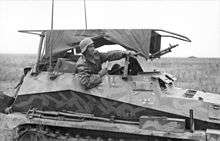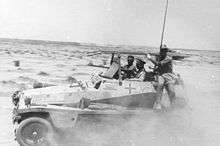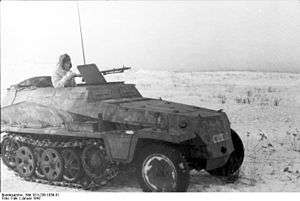Sd.Kfz. 250
| Sd.Kfz. 250 | |
|---|---|
|
Sd.Kfz. 250/2 | |
| Type | Half-track armored personnel carrier |
| Place of origin | Nazi Germany |
| Service history | |
| In service | 1941–45 |
| Used by |
Nazi Germany Kingdom of Romania |
| Wars | World War II |
| Production history | |
| Designer | Demag |
| Designed | 1939–40? |
| Manufacturer | Demag, Adlerwerke, Büssing-NAG, MWC |
| Produced | 1941–45 |
| Number built | Approx. 6,628 |
| Variants | see list below |
| Specifications (Sd.Kfz. 250/1 Ausf. A) | |
| Weight | Load: 5,800 kg (12,800 lb) |
| Length | 4.56 m (15 ft 0 in) |
| Width | 1.945 m (6 ft 5 in) |
| Height | 1.66 m (5 ft 5 in) |
| Crew | 2 + 4 |
|
| |
| Armor | 5.5–14.5 mm (0.22–0.57 in) |
Main armament | 1 or 2 x 7.92 mm (0.312 in) MG 34 machine guns |
| Engine |
Maybach 6-cylinder, water-cooled HL42 TRKM petrol 100 PS (99 hp, 74 kW) |
| Power/weight | 17.2 hp/ton |
| Transmission | 7 + 3 speed Maybach VG 102128 H |
| Suspension | torsion bar |
| Ground clearance | 28.5 cm (10 in) |
| Fuel capacity | 140 l (37 US gal) |
Operational range |
Road: 300–320 km (190–200 mi) Cross Country: 180–200 km (110–120 mi) |
| Speed | Road: 76 km/h (47 mph) |
The Sd.Kfz. 250 (German: Sonderkraftfahrzeug 250; 'special motor vehicle') was a light armoured halftrack, very similar in appearance to the larger Hanomag-designed Sd.Kfz. 251, and built by the DEMAG firm, for use by Nazi Germany in World War II. Most variants were open-topped and had a single access door in the rear.
The Sd. Kfz 250 was adopted in 1939 to supplement the standard halftrack. Production delays meant that the first vehicle did not appear until mid-1941.[1]
Development
In 1939, the Inspectorate for Motorized Troops (AHA/In 6) decided that it would be useful for small armored half-tracks to accompany tanks in the attack. They could satisfy requirements for which a larger vehicle wouldn't be needed, such as headquarters, artillery forward observer, radio, and scout vehicles.
Demag, the designer of the smallest half-track in service, the Sd.Kfz. 10, was selected to develop the "light armored troop carrier" (leichter gepanzerter Mannschafts-Transportwagen) or Sd.Kfz. 250.
To this end, the Sd.Kfz. 10 hull was shortened by one road wheel station, and an armored hull (Panzerwanne) constructed around the truncated running gear (the D1 was unique among German half tracks in having a hull rather than a chassis).
While intended as a derivative of a standard inventory item, eventually virtually every component was redesigned and specific to the Sd Kfz 250.[2]
Description
Power for the Sd.Kfz. 250 was provided by a Maybach 6-cylinder, water-cooled, 4.17-litre (254 cu in) HL 42 TRKM gasoline engine of 100 horsepower (100 PS). It had a semi-automatic pre-selector transmission with seven forward and three reverse gears: Maybach SRG, type VG 102 128 H, (SRG=Schaltreglergetriebe, VG=Variorex-Getriebe, H=Hohlachse).
Gears were first selected and then the clutch depressed to change the ratio, the next gear could then be selected in advance. In effect, the clutch acted as a gear change 'switch'. It could attain 76 km/h (47 mph), but the driver was cautioned not to exceed 65 km/h (40 mph).[3]
Both tracks and wheels were used for steering. The steering system was set up so that gentle turns used just the steerable front wheels, but brakes would be applied to the tracks the farther the steering wheel was turned. The Sd Kfz 250 also inherited the track-sparing but more complicated rollers in place of the more commonplace toothed sprockets.
The track ran on four double roadwheels overlapping and interleaved in the so-called Schachtellaufwerk design used by nearly all German half-tracked vehicles, mounted on swing arms sprung by torsion bars, track tension being maintained by an idler wheel, mounted at the rear.
The front wheels had transversely mounted leaf springs and shock absorbers (the only ones fitted) to dampen impacts.[3]
The Sd.Kfz. 250 (and its parent, the Sd.Kfz. 10) were unique among German half-track designs as they used a hull rather than a frame or chassis.
Armor
| Thickness/slope from the vertical | Front | Side | Rear | Top/Bottom |
|---|---|---|---|---|
| Superstructure | 14.5 mm (0.57 in)/30° | 8 mm (0.31 in)/35-30° | 10 mm (0.39 in)/10° | 5.5 mm (0.22 in)/?° |
| Hull | 14.5 mm (0.57 in)/12° | 10 mm (0.39 in) to 14.5 mm (0.57 in)/0° | 8 mm (0.31 in)/45° | 5.5 mm (0.22 in) |
Service history

The vehicle was used in a wide variety of roles throughout World War II. The basic troop carrier version was used as an armored personnel carrier for reconnaissance units, carrying scout sections. This basic variant usually mounted one or two MG34 machineguns. Later variants carried 20 mm, 37 mm, and even 75 mm guns to support the more lightly armed versions (see table below).
Several special-purpose variants were seen early in the war. The 250/3 and 250/5 were command variants, with fewer seats but equipped with long-range radio equipment. These were used by battalion and higher commanders as personal command vehicles, most famously the 250/3 used by Erwin Rommel in the North African campaign. Early versions had large 'bedframe' antennas, which were easy to spot at long range, making them more vulnerable to artillery fire. Later variants dispensed with this and instead used the far less conspicuous whip antenna.
The Sd.Kfz. 253 variant was fully enclosed, and was used by artillery forward observers to accompany tank and mechanized infantry units.
The initial design had a multi-facetted armoured body constructed from multiple plates, which gave good protection against small arms fire but was both slow and costly to manufacture, and resulted in a cramped interior.
Production of this early version stopped in October 1943 with some 4,200 built[1] and the complex body-shape dropped in favour of a neue art (new version) with flattened crew compartment sides made from a single piece of armour. This greatly simplified to speed manufacture began but in both variants the level of protection was minimal above rifle-calibre small-arms fire and small artillery fragments: heavy machine guns, anti-tank rifles and virtually any form of artillery could perforate the Sd.Kfz. 250, even at long range.
Variants


- Sd.Kfz. 250/1 leichter Schützenpanzerwagen
- The standard troop carrier.
- Sd.Kfz. 250/2 leichter Fernsprechpanzerwagen
- Equipped with cable-laying gear.
- Sd.Kfz. 250/3 leichter Funkpanzerwagen
- Command variant, equipped with radio equipment and a "bedstead" aerial frame.
- Sd.Kfz. 250/3-I (Fu 7, Fu 18) (Luftwaffe)
- Sd.Kfz. 250/3-II (Fu 5, Fu.Spr. f)
- Sd.Kfz. 250/3-III (Fu 8, Fu 4, Fu.Spr. f)
- Sd.Kfz. 250/3-IV (Fu 8, Fu.Spr. f)
- Sd.Kfz. 250/3-V (Fu 12, Fu.Spr. f)
- Sd.Kfz. 250/4
- Sd.Kfz. 250/4 leichter Truppenluftschutzpanzerwagen
- Antiaircraft variant armed with a dual MG 34 machine gun; never reached production.
- Sd.Kfz. 250/4 leichter Beobachtungspanzerwagen
- Observation vehicle for Sturmgeschütz detachments.
- Sd.Kfz. 250/5 leichter Beobachtungspanzerwagen
- Command variant with additional radio equipment.
- Sd.Kfz. 250/6 leichter Munitionspanzerwagen
- Ammunition carrier for assault guns.
- Sd.Kfz. 250/6 Ausf A
- carried 70 rounds for 75 mm StuK 37 L/24 gun.
- Sd.Kfz. 250/6 Ausf B
- carried 60 rounds for 75 mm StuK 40 L/48 gun.
- Sd.Kfz. 250/7
- Sd.Kfz. 250/7 leichter Schützenpanzerwagen (schwerer Granatwerfer)
- mounted an 81 mm mortar.
- Sd.Kfz. 250/7 leichter Schützenpanzerwagen (Munitionsfahrzeug)'
- Ammunition transporter - carried 66 rounds for 81 mm mortar.
- Sd.Kfz. 250/8 leichter Schützenpanzerwagen (7.5 cm)
- Support variant armed with a 7.5cm KwK 37 L/24 gun and an MG 34.
- Sd.Kfz. 250/9 leichter Schützenpanzerwagen (2 cm)
- Reconnaissance variant with a 2 cm KwK 38 autocannon and a coaxial MG (MG 34 or MG 42) in a low, open-topped turret identical to that of the Sd Kfz. 222 armoured car.
- Sd.Kfz. 250/10 leichter Schützenpanzerwagen (3.7 cm PaK)
- Reconnaissance platoon leader's variant with 3.7 cm PaK 35/36. This was the same as the antitank gun used in a towed mode early in the war. Occasionally, the gun was fitted with a small shield to protect the gunners.
- Sd.Kfz. 250/11 leichter Schützenpanzerwagen (schwere Panzerbüchse 41)
- With a 2.8 cm sPzB 41 heavy anti-tank rifle and an MG 34.
- Sd.Kfz. 250/12 leichter Messtruppanzerwagen
- Survey and artillery range spotting vehicle.
- Sd.Kfz. 252 leichter gepanzerter Munitionskraftwagen
- Ammunition carrier for Sturmgeschütz.
- Sd.Kfz. 253 leichter gepanzerter Beobachtungskraftwagen
- Artillery forward observer vehicle, with fully enclosed armoured body and artillery radios.
Plus numerous field modifications
Such as adding light artillery pieces such as the Pak35/36 to the basic version[4]
See also
References
Notes
Bibliography
- Chamberlain, Peter, and Hilary L. Doyle. Thomas L. Jentz (Technical Editor). Encyclopedia of German Tanks of World War Two: A Complete Illustrated Directory of German Battle Tanks, Armoured Cars, Self-propelled Guns, and Semi-tracked Vehicles, 1933–1945. London: Arms and Armour Press, 1978 (revised edition 1993). ISBN 1-85409-214-6
- Hogg, Ian V. Greenhill Armoured Fighting Vehicles Data Book, p. 274, "Sd Kfz 250 (alte) APC". London: Greenhill Books, 2000. ISBN 1-85367-391-9.
- Hogg, Ian V. and Weeks, John. Illustrated Encyclopedia of Military Vehicles, p. 251, "SdKfz 10 Light (One-ton) Military Tractor)". London: Hamlyn, 1980. ISBN 0-600-33195-4.
- Jentz, Thomas L. Leichter Schutzenpanzerwagen: (Sd.Kfz. 250) Ausf.A and B: History of Production, Variants, Organization and Employment from 1941 to 1945 (Panzer Tracts No. 15-1) Boyds, MD: Panzer Tracts, 2008. ISBN 0-9815382-0-7
- Niehorster, Leo W. G. German World War II Organizational Series, Vol. 4/II: Mechanized GHQ units and Waffen-SS Formations (28 June 1942) Milton Keyes, Buckinghamshire: Military Press, 2004
- Spielberger, Walter J. Halftracked Vehicles of the German Army 1909–1945. Atlgen, PA: Schiffer, 2008 ISBN 978-0-7643-2942-5
External links
| Wikimedia Commons has media related to Sonderkraftfahrzeug 250. |
